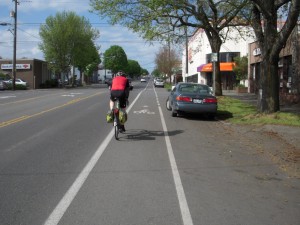A biweekly newsletter with public space news, resources, and opportunities.
A curated dispatch on all things public markets plus the latest announcements from the Market Cities Program.
Seattle, WA
4 Lanes → 3 Lanes + bike lanes

Since 1972, Seattle has installed 34 rightsizing road projects. Thirteen of these projects have been installed since 2007. Seattle’s planners note the importance of rightsizing their streets to help the 16% of the city’s households that lack a car and to improve safety and access for seniors, youth, transit riders, and those getting to and from cars.
The Seattle Department of Transportation identifies corridors to be rightsized based on Bicycle and Pedestrian Master Plans, planned road capital projects, and community requests to implement neighborhood plans. In designing a project, the agency considers traffic operations, safety and collisions, livability, accommodation for freight and transit, parking, pedestrian crossing infrastructure, pavement conditions, and traffic signals.
Stone Way North in Seattle was rightsized between North 34th and North 50th Streets. Its adjacent land use is mixed, including residential, retail and commercial space. Nearby pedestrian generators include eight schools, two libraries, and five parks. The 1.2 mile corridor also includes a number of bus routes. This project leveraged an existing repaving plan and was part of the implementation of the Bicycle Master Plan. The redesign resulted in dramatic safety gains, increased bicycling, and negligible impacts to motorized vehicle mobility. Additionally, the street saw significant new development, and is livelier.

* Seattle DOT collected before measurements for the period between April 5, 2005 and August 6, 2007. The After measurements were from August 7, 2007 to December 4, 2009.
The rich text element allows you to create and format headings, paragraphs, blockquotes, images, and video all in one place instead of having to add and format them individually. Just double-click and easily create content.
The rich text element allows you to create and format headings, paragraphs, blockquotes, images, and video all in one place instead of having to add and format them individually. Just double-click and easily create content.
Body Text Body Link
The rich text element allows you to create and format headings, paragraphs, blockquotes, images, and video all in one place instead of having to add and format them individually. Just double-click and easily create content.
Here is some highlighted text from the article.




Headings, paragraphs, blockquotes, figures, images, and figure captions can all be styled after a class is added to the rich text element using the "When inside of" nested selector system.
Headings, paragraphs, blockquotes, figures, images, and figure captions can all be styled after a class is added to the rich text element using the "When inside of" nested selector system.
Headings, paragraphs, blockquotes, figures, images, and figure captions can all be styled after a class is added to the rich text element using the "When inside of" nested selector system.

We are committed to access to quality content that advances the placemaking cause—and your support makes that possible. If this article informed, inspired, or helped you, please consider making a quick donation. Every contribution helps!
Project for Public Spaces is a 501(c)(3) tax-exempt organization and your donation is tax-deductible within the guidelines of U.S. law.